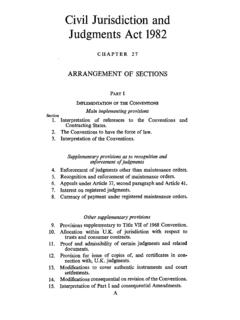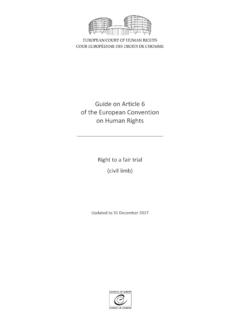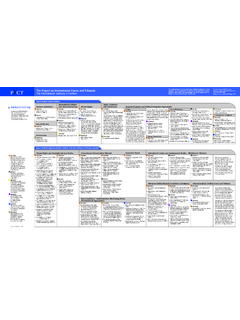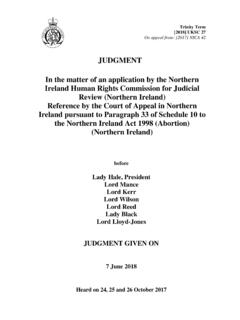Transcription of Examples of Good Practices in the Implementation …
1 Examples of Good Practices in the Implementation of the International Framework for the Protection of the Rights of the Child in the Context of Migration United Nations Children s Fund (UNICEF)* DRAFT 18 June 2010 * With contributions from the National University of Lanus, Argentina Table of Contents I. Introduction .. 1 1. Background .. 1 2. OHCHR Study on challenges and best Practices in the Implementation of the international framework for the protection of the rights of the child in the context of migration .. 1 3. Outline of good Practices included in this document .. 4 4. UNICEF Working General Principles on Human Rights and Children Affected by Migration .. 8 II. National legislation policies and practice including mechanisms to assess and address challenges in the Implementation of the international framework for the protection of the rights of the child in the context of migration .. 12 1. Argentina.
2 12 Regularization - Patria Grande Program .. 12 Migration Law, Argentina (No. , 2004) - Social Rights for Undocumented Migrants .. 13 2. Belgium, Italy & the Netherlands .. 13 Right to education for irregular migrants .. 13 3. Burundi .. 14 Accelerated language education for repatriated children .. 14 4. Ecuador .. 15 Constitutional Reform and Migrants Rights (2008) .. 15 Social protection programs to support return migrants and their families .. 15 5. France .. 16 Right to Health for Undocumented Migrant Children .. 16 6. Guatemala and Mexico .. 17 Primary Education for Migrant Children (PRONIM) .. 17 7. Panama .. 18 Non detention of migrant children .. 18 8. Philippines .. 19 Filipino Migrant Welfare Fund .. 19 9. South Africa .. 21 High Court: Unaccompanied migrant children in detention Liberty, Due process, and Effective Protection Policies .. 21 10. Spain .. 22 Constitutional Court: Repatriation of Unaccompanied Migrant Children for Family Reunification in Country of Origin Right to Be Heard, Due Process, and Access to Legal 22 Right to Health for Undocumented Migrant Children.
3 23 11. Uruguay .. 23 Family reunification law .. 23 12. Venezuela .. 24 Alternatives to detention .. 24 III. Joint efforts and strategies available at the bilateral, regional and international levels to assess and address challenges in the Implementation of the international framework for the protection of the rights of the child in the context of migration .. 25 13. European 25 Research on Regularisation Programmes and Mechanisms .. 25 14. European Parliament .. 26 Migrant detention conditions .. 26 15. Guatemala & Mexico .. 27 Building the capacities of migration authorities .. 27 16. MERCOSUR .. 28 Regularization .. 28 IV. The work of National Human Rights Institutions and other relevant stakeholders .. 30 17. China/UNDP .. 30 Capacity Building in Promoting Social Inclusion for Migrant Workers and their Families (UNDP) .. 30 18. European Committee on Social Rights .. 30 Access of undocumented child migrants to the right to health care.
4 30 19. European Court Of Human Rights .. 31 Protection of unaccompanied child migrants against labour exploitation .. 31 20. Inter-American Court of Human Rights .. 33 Right to child registration, to a name, a nationality, and access to education .. 33 21. Latin America/UNFPA .. 34 Regional Project on Sexual and Reproductive Rights of Young and Women Migrants .. 34 22. Latvia/Civil Society .. 35 Guide for Young People Considering Migration .. 35 23. Mexico/UNICEF/IOM/UNHCR .. 36 Capacity to gather information and generate statistics .. 36 Securing a new model for the protection of unaccompanied migrant children .. 37 Building capacity in the Migration Institute .. 38 24. Morocco/UNICEF .. 38 Capacity Building on Migration, Children and Human Rights .. 38 25. Philippines .. 40 Economic and social services to overseas Filipinos and families left 40 26. South Africa/UNICEF .. 42 Situation Analysis of Migrant Children in South Africa.
5 42 27. UN Committees .. 42 Standards on the protection of migrants .. 42 28. West Africa .. 45 Child Mobility and Integrated Protection .. 45 1 I. Introduction 1. Background Today, an estimated 214 million migrants, nearly three percent of the world population, live outside their country of birth. This figure includes millions of migrant children and adolescents, who have either migrated with their parents or unaccompanied. While migration is a strategy used by individuals and families to escape exposure to risks by moving to a safer region or country, it can also be a strategy used for upward social mobility, to access better job opportunities, education and health care. When individual, family and community vulnerabilities become the main driver of migration, they are clearly and intrinsically linked to human rights deprivations in countries of origin. This includes poverty, inequalities, gender-based discrimination, lack of opportunities, as well as abuse, violence, and armed conflict.
6 Migration is also a coping strategy that presents opportunities for migrants and their families. Depending on the modality of migration regular, irregular, legal, illegal, short/long term, with or with families migrants, particularly children and adolescents, may be vulnerable to human rights deprivations throughout the entire process of migration. Increasingly restrictive migration policies can contribute to exacerbating vulnerabilities, particularly in case of undocumented migrants. The fundamental problem faced by children and adolescents is their invisibility: the absence of a child perspective within migration laws and policies, and the absence of a migrant perspective in childhood policies. This results in the deprivation of their rights, discrimination and even exploitation. In depth analyses is needed of existing migration laws and policies that may affect all migrants to determine whether or not age and gender-sensitive responses are in place.
7 This means that the analyses take into account the core principles of human rights including: universality, non-discrimination, best interest of the child, and gender equality. The principle of non-discrimination is essential for the operationalization of the provisions of the CRC, CEDAW and other human rights treaties. 2. OHCHR Study on challenges and best Practices in the Implementation of the international framework for the protection of the rights of the child in the context of migration In resolution 12/6 adopted by the Human Rights Council on 1 October 2009 entitled Human Rights of Migrants: Migration and the Human Rights of the Child , the Office of the High Commissioner for Human Rights (OHCHR) was requested to prepare a study on challenges and best Practices in the Implementation of the international framework for the protection of the rights of the child in the 2 context of migration, in consultation with relevant stakeholders, including States, regional organizations, civil society organizations and national human rights institutions, and requests that the study be available on the website of the Office prior to the fifteenth session of the Council, and to disseminate it to all relevant international forums (Para.)
8 8). UNICEF was requested to provide Examples of good practice1 with particular regard to: (a) National legislation, policies and practice, including mechanisms to assess and address challenges in the Implementation of the international framework for the protection of the rights of the child in the context of migration; (b) Joint efforts and strategies available at the bi-lateral, regional and international levels to assess and address challenges in the Implementation of the international framework for the protection of the rights of the child in the context of migration; and (c) The work of National Human Rights Institutions and other relevant stakeholders. The present document represents UNICEF s contribution of Examples of Good Practices . This document explores and describes different programs in countries of origin, transit and destination, aiming in each case to provide background information as well as a description of the policy or programme in question.
9 Examples have been provided for each of the three categories specified by OHCHR. Though it is important to note that, while these are submitted in response to a request for Best Practices , in general, the literature is not conclusive about the results and success of each of the experiences described herein nor does this set of Examples represent an exhaustive list. The thirty Examples provided touch on a variety of human rights and child protection initiatives, including legislative and policy reform that aim to protect the rights of a number of categories of vulnerable children and women including unaccompanied children, children migrating irregularly, children who have been repatriated, etc. The first section includes a set of national policies, laws, and Practices meant to promote, protect or fulfil the rights of migrant children and children affected by migration ( , children left behind).
10 In addition, this section also includes a number of judgments by national courts, as the judiciary can play a key role in monitoring migration policies and assessing them against international human rights standards. The second section, on joint efforts at bi-lateral and regional level, contains Examples of bilateral initiatives intended to ensure consular protection to migrants in host countries, and regional programmes and activities adopted by either governments (MERCOSUR Member States) or regional bodies (EU agencies) regarding key migrants rights issues: regularisation policies and detention 1 UNICEF tends towards the term good Practices rather than best Practices as the term best Practices is contentious given the range of UNICEF programming and the specific contexts of operation in each country and for this reason the term good Practices is being used (PPP Manual, 2009 page 288).


















